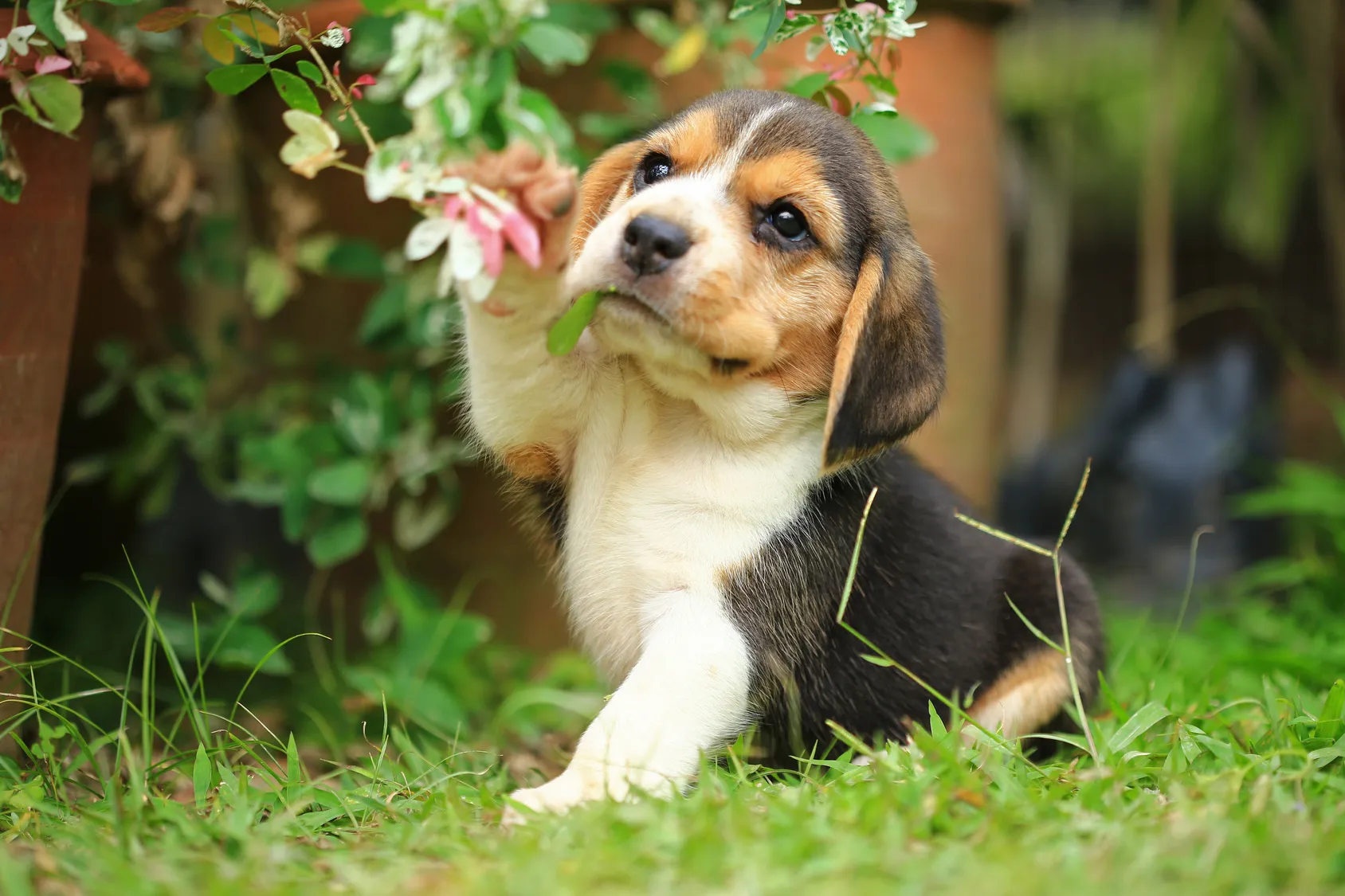Beagle
The Beagle's short legs can be deceiving – this medium-sized dog keeps you on your toes and is always full of surprises! This friendly breed is active, fearless and extremely clever.
The Beagle's short legs can be deceiving – this medium-sized dog keeps you on your toes and is always full of surprises! This friendly breed is active, fearless and extremely clever.

© fast_9 / stock.adobe.com
The Beagle is a compact, medium-sized dog. It can reach up to 40cm in height and weighs up to 18kg. The Beagle’s short legs are incredibly strong and provide speed and endurance. The head is long and the deep-set, rounded floppy ears make the Beagle extremely popular. Every colour apart from liver (brown) is recognised. The most common colour variations are bi-colour brown and white, red and white, yellow and white, or even a black, white and brown tricolour. According to the breed description, the tip of the tail must always be white.
The short shiny fur is very low-maintenance, for example, after a walk in the woods where the Beagle spends the majority of the time deep in the undergrowth…
The friendly, constantly raised tail is great to spot your Beagle scurrying around outdoors and reflects its hunting dog heritage.
Beagles know what they want, and their hunting dog heritage gives them a good sense of smell and speed. As a result, the breed has a pronounced hunting instinct – so many Beagles disappear off into the bushes upon sensing a hare in spite of their owner calling them to return! Although these smart dogs look innocent, they need a strong hand. If you don’t make it clear to your Beagle from the start who’s in charge, you’ll have to accept your dog calling the shots. Originally bred as hunting dogs, Beagles energetically pursue their goal, be it on walks in the wood or day-to-day life.
As a pack dog, Beagles are sociable and integrate well with companions of all ages, breeds and sizes. When they live with other dogs, it is even more important to set boundaries and train the Beagle and its companions firmly and consistently. If not, the short-legged Beagle will try to force itself into the alpha dog role and will quite literally turn your house upside down. One of its characteristics as a pack dog is a certain insatiability when it comes to food. If it shares food with other dogs, only the fastest will end up being the fullest! The Beagle’s appetite often knows no limits and doesn’t stop even with unhealthy or dangerous food. Christmas chocolate – need we say more…
Intelligent dogs like Beagles need activity. Beagles love mental games, whilst agility and long walks with their loved ones also prove a hit. The main thing is that there’s something going on! Beagles like to get everywhere, making them an ideal choice for active individuals. They feel particularly at ease in lively families, those with children too!
It can’t be stressed enough that even though Beagles like to look cuddly, they are actually intelligent, self-confident dogs and therefore need a strong hand. Consistency is fundamental to living with a Beagle! They aren’t uncooperative or untrainable, but they do know what they want and can be very dominant if they don’t recognise their owners as the alpha. Don’t let yourself be bribed by a pleading look from their bright round eyes and don’t capitulate. Instead, make it clear to your Beagle who’s boss. As intelligent animals, Beagles are actually really willing to learn and with a bit of consistency will become great four-legged companions!

These characteristics don’t come about by chance. Beagles were actually bred as hunting dogs for centuries, and the breed goes back to the so-called Hubert’s Hound or Northern Hound introduced by the Normans when they conquered England in 1066. Around 1400, the Beagle was paired with the mottled Southern Hound from the south of France. For the original breeders, it was important for the offspring to be suitable hunting dogs that could be used in the pack. The name ‘Beagle’ emerged around 1515 in the household diaries of Henry VIII. In 1615, a small-breed dog called the ‘Little Beagle’ was mentioned, which fit in the hunter’s saddle bag due to its compact size. A prominent hunting instinct was named after this outstanding hunt dog: at this time, the term ‘Beagling’ defined a hunt with support from a pack of dogs. However, the Beagle was first recognised by the British Kennel Club only in 1890.
This heritage lends Beagles both their appearance and friendly character. However, as hunting and pack dogs they do know what they want. They are intelligent, single-minded and friendly. Highly sociable, they also make ideal family dogs!
Due to their size, Beagles are not retrievers – even a hare is too heavy for this medium-breed dog. However, their pronounced hunting flair and intuition makes them ideal for drag-hunting. They aren’t scared of water and love working together with the pack.
Beagles make perfect four-legged friends for active families. Alternatively they are deployed as therapy dogs – and unfortunately also as laboratory animals due to their gentle nature… Indeed, Beagles are the most commonly used dog breed in scientific research.
Their outstanding sense of smell makes Beagles perfect for border control work. So-called Beagle Brigades have been deployed by the United States Bureau of Customs and Border Protection since the 1980s to search for illegally smuggled foods, plants and animal parts.
For centuries, Beagles have been bred based on their suitability as hunting dogs. However, targeted breeding also has disadvantages. As is the case with many dog breeds, the Beagle too is predisposed to certain diseases. Slipped discs, obesity and meningitis-arteriitis can be particularly prominent due to the Beagle’s stocky build.
As prey-oriented dogs, Beagles have an insatiable appetite. When they live with other dogs, the fastest to the food bowl ends up the fullest! Unfortunately this can all too often lead to obesity amongst family dogs that don’t get much exercise. The best precaution is keeping active and mentally and physically tiring out your Beagle. Healthy nutrition is another cornerstone of keeping a Beagle. Don’t give into every begging whimper with a tasty treat – especially not with unhealthy table scraps or sweeties! Beagles unfortunately don’t always know what’s good for them and what isn’t.
The spine and joints of overweight dogs are put under great pressure. Long, small Beagles are therefore prone to slipped discs. Meningitis-arteriitis, also known as Beagle Pain Syndrome, can be detected. This relatively common disease of the spinal cord causes festering inflammation of the spinal meninges and blood vessels. The cause remains unknown. Therapy takes place over several months, including a long course of antibiotics.
Another common illness amongst Beagles is Hound ataxia – a neurological disorder often described as degenerative myelopathy. Degenerative inflammation of the spinal cord and grey matter in the brain stem are evident through movement disorders and spastic paralysis. However, this does not appear to cause the dog any pain. Excessive rumen in the food is pinpointed as the cause.
The Beagle’s floppy ears are unfortunately prone to ear infections. Fixed secretion or foreign bodies like blades of grass provoke painful inflammation, and even bugs such as mites can find a happy home in your Beagle’s ears… Initial warning signs are heavy shaking or tilting of the head.
The Beagle’s big round eyes can be affected by illness too. Glaucoma, corneal dystrophy or retina atrophies are particularly common eye diseases amongst the breed.
All in all, Beagles are active and intelligent dogs that can live for 12 to 15 years. If you want your Beagle to live a long and healthy life, you should ensure you provide healthy food and lots of activity to prevent obesity and make regular visits to the vet.
Senior Beagles of course need special care. If your Beagle’s sight, sense of smell and mobility appear to deteriorate, you should ask your vet for advice and get your pet examined for potential degenerative joint diseases. Healthy nutrition is essential for older dogs too. After all, you want to be sure that your dog is getting all its nutrients without unnecessary weight gain!
Although the Beagle breed is originally from Great Britain, targeted breeding has also taken place in Germany. Beagle breeders can register at numerous pedigree dog associations across the whole of Germany.
You might not think that a family dog requires any documentation, but you shouldn’t trust any untrustworthy breeders offering ‘pedigree dogs without documentation’. Breeding animals is a time-consuming and expensive hobby. Breeders don’t just have to feed their animals until they are taken into new homes and socialise them with lots of love – they are also responsible for the breed’s gene pool. This goes beyond mere aesthetic appeal and concerns the individual health of each animal. Breeding associations supervise the breed’s housing conditions and also ensure that targeted breeding takes place. On the other hand, untrustworthy breeders often pair siblings or closely related animals, which increases the risk of hereditary diseases… Pups from such frivolous breeders are often neither socialised nor vaccinated, therefore can suffer from diseases from an early age.
In contrast, a reputable breeder can provide you with information on your future pet’s parents – even including medical reports if you ask. Taking care of a litter is time-consuming, so don’t be surprised if your trusted breeder offers just two litters per year with a very limited selection. At the end of the day, Beagle mums need recovery time! The puppies are ready for their new home at the age of eight to ten weeks.
Pedigree dogs are expensive but worth the money.
Alternatively, many dogs at rescue shelters are waiting for a good home – including lots of Beagles! Animal shelter employees can usually give you detailed information on the character and background of their animals. Adult dogs might not be as cute as puppies, but giving a grown-up Beagle a fantastic new home can be really rewarding! They will shower you and your family in love and will enrich your life with their sunny disposition and curious personality.
We wish you and your Beagle a wonderful adventure-packed life together!
The Beagle's short legs can be deceiving – this medium-sized dog keeps you on your toes and is always full of surprises! This friendly breed is active, fearless and extremely clever.
The Golden Retriever is still one of the most popular dog breeds, especially with families. It is defined not just by its docility, but shows numerous other qualities too. Read in the following article everything you need to know about the Golden Retriever.
The German Shepherd is one of the most popular utility dog breeds in the world, though the willing-to-learn and people-focused nature of these versatile dogs also makes them suitable for family life.